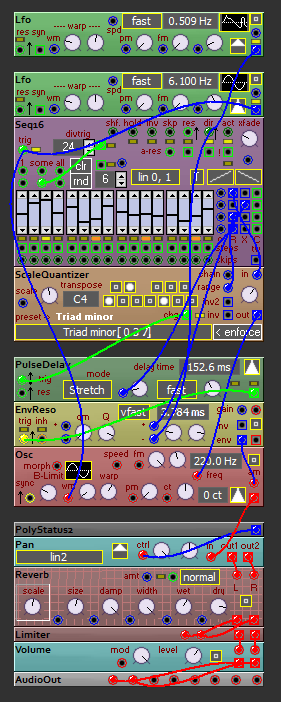2022-01-27
New envelope - of sorts
NOTE: as of version 2022.1.28.0 the module has inbuilt stretch on the trig input, and no extra module is needed for pulse lengthening.
![]()
Published as pre-release. 2022.1.26.0]
Made a new envelope module of sorts.
I had been experimenting before with a State Variable Filter (SVF) set to low frequencies as a method of getting some ressonance in the processed signal. Worked that out to use a time setting instead of a frequency setting for the filter and allowing for very long times (ultra low frequencies … like once per hour) and for pretty short times like 500µs (2kHz - in the audio range).
There are some details and an example patch (including a short mp3 recording from it) in the more section.
The module has the user interface of an envelope generator, but internally an SVF is being used with it’s low-pass signal being used as the envelope. The trig input is normalised to a zero or one signal, but is can be adjusted with the gain input if needed.
The module does not really have a rise and a fall time like a regular envelope, but rather it will pass on the input pulse with some ringing on a possibly very low frequency (or in the audio range for short times).
The inh input when active will set the input impulse to zero, so can be used as a digital modulation .
The env output gives the filter output while the inv output returns 1.0 - env.
There is an inbuilt VCA too - the red input is multiplied by the env signal and then passed to the red out.
Some interesting effects can be obtained with using very short times with a highish Q setting, the filter ringing will be present then and in the audio range.
With the trig input being held high the module behaves like a Very Low Frequency SVF (VLFSVF) when using the gain input for a signal and the env output as the output.
![]()
The input pulse needs a certain length for this to work nicely, I use the pulse stretch mode of the PulseDelay module currently. I’m considdering to give the modue a built-in pulse stretcher, although an external stretcher will be more flexible. Or alternatively make a more involved reso envelope - experimenting with it.

An example patch is displayed on the right and when you have the right Wren version (pre release 2022.1.26 or later) you can try the patch yourself,
It uses a Seq16 to play some notes that are quantized to a minor triad by the ScaleQuantizer. Whenever the quantizer makes a new value it sends out a a narrow pulse (on its chg output) to the PulseDelay module which (in stretch mode) stretches it a bit (with the stretch time being modulated here by the sequencer).
The stretched pulse goes into the EnvReso module which is set to a time that will give some audio artifacts, and with that it controls the amplitude of the Osc module.
The sine LFO controls the tempo and the random LFO changes the sequencer direction - which works nice on a poly patch (as when the LFO is in random mode it will make signals that are different on each voice). Polyphony was set to three for this patch.
The EnvReso time is modulated from the sequencer as well, and then there is a little shape modulation of the VCO from the sine set LFO - which gives a bit more body to the sound.
Then the bottom block; with the Pan module it sends out the signals to the left or right depending on the voice (controlled by the PolyStatus2 module). Then a tad of reverb is added and finally there is a mildly distorting limiter to keep the signals from going too high.
Could add a bit of random (with another random generating module - like RandSigs for instance) to the pm input of the sine LFO to make it more lively.
Anyway - made a small recording where you can hear it - and on the patch just try stuff :¬)
Add comment
Fill out the form below to add your own comments